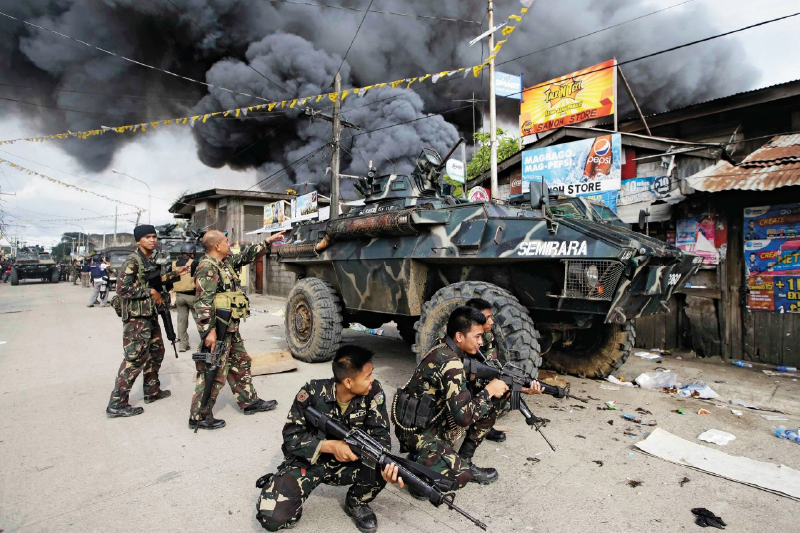“[PRESIDENT AQUINO] will be remembered not by the peace pact that he forged but by the peace pact that he broke,” the Moro National Liberation Front (MNLF) posted in a Facebook status dated August 16.
On the same day, GMA News Network confirmed that the movement had declared independence on August 12, with their claim covering the Bangsamoro regions of Zamboanga, Sulu, Tawi-tawi and Sabah. Chairman of the MNLF Islamic Command Council Habib Hashim called the Bangsamoro Framework Agreement (FAB) an “abrogation” of the 1996 Peace Agreement between the Government of the Republic of the Philippines (GPH) and the MNLF.
The FAB called for structural reform through the creation of a new autonomous Bangsamoro region to replace the Autonomous Region of Muslim Mindanao (ARMM), which Aquino has dubbed a “failed experiment.”
Malacañang did not recognize the declaration, calling MNLF Chairman Nur Misuari’s move “misguided.” Presidential spokespersons Abigail Valte and Edwin Lacierda said that the 1996 Peace Agreement was in fact still being enforced and appealed to Misuari “not to look at his own personal interest, [but that of] the peoples of Mindanao.”
The peace process between the Moro Islamic Liberation Front (MILF) and the government will proceed as scheduled unless the MNLF shows force, according to Fr. Albert Alejo, a member of the GPH Peace Panel under the Reciprocal Working Committee on Socio-Economic Reforms.
However, Zamboanga City fell under siege last September 9 as MNLF forces captured four barangays, displacing some 13 000 people. The attack took place on the same day that the government was set to continue FAB talks with the MILF.
As of press time, a ceasefire between the combatants has been called.
Broken promises
The MILF broke away from the MNLF in 1981 after expressing dissatisfaction with the 1976 Tripoli Agreement, which established the Autonomous Region of Muslim Mindanao (ARMM). While the MILF restricts the definition and scope of the Bangsamoro region to cover only Moro peoples, the MNLF believes the Bangsamoro to be territorial, inclusive of Christians and Lumads (indigenous peoples) who live in the region.
“In settling, seeking a peace agreement with the MILF, they’re practically talking about the same piece of land that has already been the subject of the peace agreement between the government and the MNLF,” explained Alejo. “They have a point!”
In an interview with The Philippine Star, Misuari stressed that the 1996 Peace Agreement is transgressed by the MILF-GPH negotiations. “The Philippine Government is proposing the closure of our peace process… [which] means [they] will do away with the series of peace treaty agreements and on peace accord that we signed over a number of decades in our collective efforts with the participation of the Organization of Islamic Cooperation 57 member-states,” he added.
This perspective is contrary to Presidential Spokesman Edwin Lacierda’s statement, as reported in The Philippine Star. “The Bangsamoro Framework Agreement will benefit all Bangsamoro… We ask MNLF to seriously look… into this agreement, not as MNLF, but as Bangsamoro, and it includes everyone: MILF, MNLF and the Lumads,” he said.
Ikram Tawasil, Chief of Staff of the National Commission on Muslim Filipinos, echoed this sentiment. He admitted that while fully reviewing and implementing the 1996 Peace Agreement may be necessary, all of its previous terms and conditions have also been incorporated into the new Bangsamoro Framework Agreement.
Discrepancy and dissatisfaction
As groups in question differ in their definition of the Bangsamoro, they also differ in their vision of it.
“The MNLF might think that the MILF agreement is a sellout,” explained Alejo, citing territorial differences. “It is less than what the Bangsamoro wants… Now, the MNLF says, ‘Look at what you got! It’s smaller than what we negotiated as MNLF. If you had gotten much bigger territory and a better government deal, then maybe we’d submit to you. But it looks like we’re not getting any increase beyond what we have already previously negotiated.’”
Apart from a clash of ideals, Tawasil connected the criminality in the area and dissatisfaction of Mindanaoan sectors to the fact that Mindanao is underdeveloped. “We [cannot] develop [a locality] because it is not in peace,” he said, adding that GPH agencies are hindered from carrying out tasks in Mindanao due to the lack of ensured security. “But I do not think that is a justifiable reason,” he commented. Rather, he believes a community must first experience development before peace is achieved.
Mindanao alone contributes largely to the economy of the country, but Tawasil says, “If Mindanao is still in the midst of conflict and war, one of two things may happen: The whole nation could move economically forward, leaving Mindanao, or it could not move at all.”
Tawasil called for the resolution of the situation. He said, “You cannot expect the whole nation moving forward leaving Mindanao in a state of war or in a state of conflict.” He added, “If you will leave it as it is, then it will be a breeding ground for [rebel] recruitment and people would only want to wage war against the government.”
Ayeem Igasan, a psychology freshman who hails from Zamboanga City, also noted the dependence of Mindanaoans on the GPH. “Basically, when we’re given this independence, we are delaying more of what was supposed to be progress,” she said. “I think they still need all the help from the government and that they need all the support they can get.”
She also believes that the issue is not one of religion, but one of politics. “As a Muslim, I’ve grasped the reality of living in an environment full of Christians, and I’m completely fine with it,” she said.




